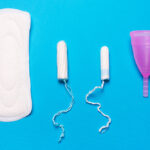
It’s totally normal to have a little trouble inserting a tampon for the first time, but selecting the right time, tampon size, and position, can make the whole process a lot easier. For example: It’s easier if you don’t feel rushed and you have privacy; plan a good time when you can practice–you should be on your period. Tampons come in different sizes and for different amounts of flow such as lite, regular, super, or super plus. Some tampons come with an applicator (the device used to insert the tampon), while others don’t. Tampons with applicators come in plastic or cardboard. It’s important to start with a light or slender tampon and insert it while your menstrual flow is moderate to heavy. This will allow the applicator or tampon to glide in easily. Many girls find it helpful to either sit or stand while inserting a tampon. Some prefer to stand in a squatting position, while others find it easier to insert a tampon while sitting on the toilet. When inserting the tampon, visualize an imaginary line between your tampon and your tail bone. You’ll insert the tampon at this angle. It may be helpful to take some slow, deep breaths (in and out) before inserting the tampon, to help you relax. You can also use a mirror to help see where you are inserting the tampon.
About 2% of women are born with a very small opening in their hymen, which can prevent you from inserting your tampon. If you are still unable to insert your tampon (after several attempts), make an appointment with your health care provider (HCP).
Our health guides are developed through a systematic, rigorous process to ensure accuracy, reliability, and trustworthiness. Written and reviewed by experienced healthcare clinicians from Boston Children's Hospital, a Harvard Medical School teaching hospital and consistently ranked as a top hospital by Newsweek and U.S. News & World Report, these guides combine clinical expertise, specialized knowledge, and evidence-based medicine. We also incorporate research and best practices from authoritative sources such as the CDC, NIH, PubMed, top medical journals, and UpToDate.com. Clinical specialists and subject matter experts review and edit each guide, reinforcing our commitment to high-quality, factual, scientifically accurate health information for young people.